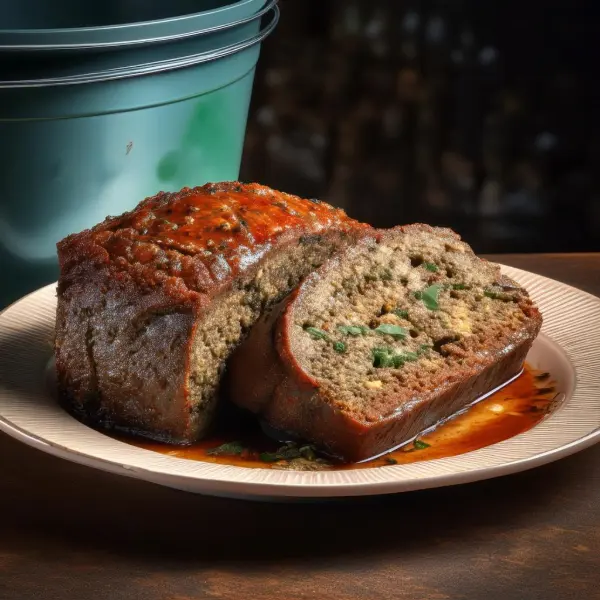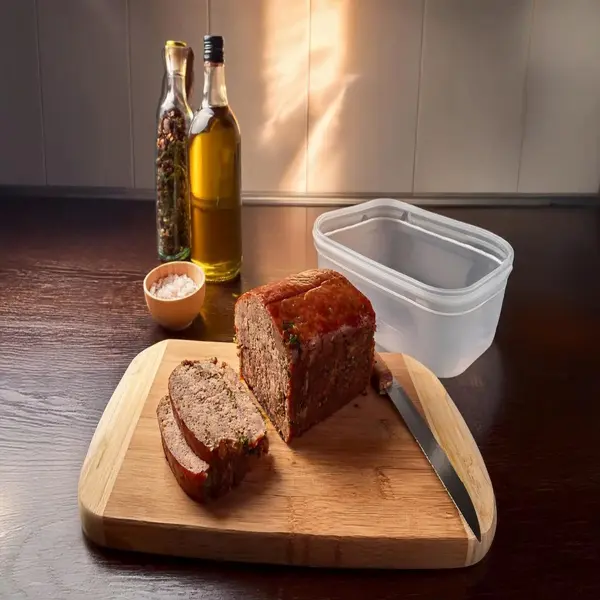Introduction :
Leftover meatloaf is a versatile, delicious option for a quick meal or a creative recipe base. However, many people wonder, “How good is leftover meatloaf good for?” This question often arises because the safety and quality of leftovers depend on how they’re stored and used. In this guide, we’ll explore the shelf life of shelf life of leftover meatloaf, discuss how to store it properly, and provide tips on recognizing when it’s no longer safe to eat. Additionally, we’ll include creative ways to use leftover meatloaf, a detailed recipe, and insights into its nutritional value. Let’s dive into everything you need to know about ensuring your leftover meatloaf stays good for as long as possible.
How Long is Leftover Meatloaf Good For?
Understanding the Shelf Life of Leftover Meatloaf
The shelf life of leftover meatloaf depends on factors such as how it was cooked, stored, and handled. Generally, properly storage tips for meatloaf can last up to 3–4 days in the refrigerator. When frozen, its shelf life extends to about 3 months. However, these timeframes rely heavily on using safe storage practices to prevent bacterial growth.
Factors That Affect Shelf Lif
Several factors influence how long leftover meatloaf stays good for:
- Storage Temperature: Keeping meatloaf at a consistent temperature of 40°F (4°C) or below is critical.
- Packaging: Airtight containers or vacuum-sealed bags help minimize air exposure.
- Ingredients Used: Meatloaf made with perishable ingredients, like eggs and milk, may spoil faster.
By paying close attention to these factors, you can ensure your storage tips for meatloaf remains safe to eat for as long as possible.
How Long Can You Keep Leftover Meatloaf in the Fridge?
Leftover meatloaf can safely be stored in the refrigerator for 3–4 days. To maximize its freshness:
- Place the meatloaf in an airtight container or wrap it tightly with aluminum foil or plastic wrap.
- Store it on the top shelf of your fridge to keep it at the optimal temperature.
Pro Tip: Label the container with the date so you can track how long it has been stored. This simple habit helps prevent accidental consumption of expired leftovers.
How Long is Leftover Meatloaf Good For in the Freezer?
Freezing leftover meatloaf extends its shelf life significantly, allowing you to enjoy it up to 3 months later. When freezing meatloaf:
- Slice it into individual portions for easier reheating.
- Wrap each slice in plastic wrap, then place them in a freezer-safe bag.
- Remove as much air as possible from the bag to prevent freezer burn.
When you’re ready to use frozen meatloaf, thaw it in the refrigerator overnight. Avoid thawing meatloaf at room temperature, as this can lead to bacterial growth.
Why Proper Storage is Crucial
storage tips for meatloaf correctly not only extends its shelf life but also preserves its flavor and texture. Improper storage can result in dry, unappetizing leftovers or even spoilage. Taking the time to store your meatloaf properly ensures that it remains a safe and tasty option for your next meal.
Signs That Leftover Meatloaf Has Gone Bad
How to Tell If Leftover Meatloaf is No Longer Good
It’s essential to recognize when leftover meatloaf has gone bad. Eating spoiled meatloaf can pose significant health risks, so knowing the warning signs is crucial. While proper storage extends the shelf life of meatloaf, there are several indicators to watch for when determining its freshness.
Visual Indicators of Spoilage
One of the most apparent signs that leftover meatloaf is no longer good is its appearance. Here’s what to look for:
- Discoloration: Fresh meatloaf should have a consistent color. If you notice grayish, green, or black spots, it’s likely spoiled.
- Mold: The presence of fuzzy or powdery mold spots indicates that the meatloaf has gone bad.
- Dryness: While slight drying is normal over time, excessive dryness or cracking on the surface may suggest the meatloaf is no longer fresh.
By paying attention to these visual cues, you can avoid consuming meatloaf that is past its prime.
Smell as a Key Indicator
Your sense of smell is another reliable tool for determining the freshness of leftover meatloaf. Spoiled meatloaf often emits a sour, unpleasant, or ammonia-like odor. If the smell is off-putting or noticeably different from when it was freshly cooked, it’s best to discard it.
Texture Changes That Signal Spoilage
Another way to determine if leftover meatloaf is good is by checking its texture. Spoiled meatloaf may have:
- A Slimy Surface: This is a common sign of bacterial growth and means the meatloaf should not be consumed.
- Excessive Softness: If the meatloaf feels mushy or unusually soft, it’s no longer safe to eat.
Always wash your hands after handling potentially spoiled meatloaf to prevent cross-contamination with other foods.
Why Spoiled Meatloaf Should Be Avoided
Eating spoiled meatloaf can lead to foodborne illnesses caused by harmful bacteria such as Salmonella or E. coli. Symptoms may include nausea, vomiting, diarrhea, and fever. To protect yourself and your family, err on the side of caution if you’re unsure about the freshness of your leftovers.
How to Minimize the Risk of Spoilage
To reduce the chances of meatloaf spoiling prematurely:
- Store it in airtight containers to limit air exposure.
- Refrigerate leftovers promptly after the meal.
- Consume refrigerated meatloaf within 3–4 days, and frozen meatloaf within 3 months.
Following these practices ensures your leftover meatloaf stays safe and delicious for as long as possible.
How to Properly Store Leftover Meatloaf
Proper Storage Techniques to Keep Leftover Meatloaf Fresh
Storing leftover meatloaf correctly is key to extending its shelf life and maintaining its quality. Whether you’re keeping it in the refrigerator for a few days or freezing it for future use, following proper storage practices ensures your meatloaf stays safe and delicious.
Using Airtight Containers for Refrigeration
Airtight containers are one of the best tools for preserving leftover meatloaf. Here’s why:
- Limits Air Exposure: Prevents the meatloaf from drying out or developing a stale taste.
- Minimizes Bacterial Growth: Airtight seals keep contaminants out, reducing the risk of spoilage.
- Prevents Odor Transfer: Keeps strong food odors in check, protecting the flavor of your meatloaf.
To refrigerate, place your meatloaf in an airtight container or wrap it tightly in aluminum foil or plastic wrap. Ensure the refrigerator temperature is set at or below 40°F (4°C) for optimal freshness.
Freezing Leftover Meatloaf for Long-Term Storage
Freezing is an excellent option for leftover meatloaf when you’re not planning to eat it within a few days. Follow these steps for proper freezing:
Step 1: Portion the Meatloaf
Slice the meatloaf into individual portions. This makes it easier to thaw and reheat only what you need.
Step 2: Wrap Each Slice
Wrap each slice tightly in plastic wrap, ensuring there are no exposed areas.
Step 3: Use Freezer-Safe Bags or Containers
Place the wrapped slices in a freezer-safe bag or container. Remove as much air as possible to prevent freezer burn.
Step 4: Label and Date
Label the package with the contents and date of freezing. This helps you keep track of how long it’s been stored.
Frozen meatloaf can last up to 3 months when stored properly.
Tips for Thawing Frozen Meatloaf Safely
When it’s time to use your frozen meatloaf, thawing it correctly is crucial for maintaining its quality and safety. Avoid thawing at room temperature, as this can promote bacterial growth. Instead:
- Refrigerator Thawing: Place the frozen meatloaf in the refrigerator overnight. This is the safest and most effective method.
- Microwave Thawing: Use the defrost setting on your microwave for quicker results, but cook the meatloaf immediately after thawing.
Common Mistakes to Avoid When Storing Leftover Meatloaf
Even with good intentions, improper storage can shorten the shelf life of leftover meatloaf. Here are some common mistakes to avoid:
Leaving Meatloaf Out Too Long
Leftover meatloaf should not be left at room temperature for more than 2 hours. This is the temperature “danger zone” where bacteria multiply rapidly.
Not Sealing Containers Properly
Containers that aren’t sealed tightly can allow air and moisture to enter, leading to spoilage or freezer burn.
Freezing Without Wrapping
Freezing meatloaf without adequate wrapping can result in freezer burn, which affects texture and flavor.
Why Proper Storage Matters for Leftover Meatloaf
Taking the time to store leftover meatloaf properly preserves its taste, texture, and safety. By following these guidelines, you can ensure that your leftovers remain as delicious and versatile as when they were freshly cooked.
Creative Ways to Use Leftover Meatloaf

Transforming Leftover Meatloaf into Delicious New Dishes
Leftover meatloaf doesn’t have to be boring. With a little creativity, you can turn it into a variety of delicious dishes that feel fresh and exciting. From quick sandwiches to hearty casseroles, the possibilities are endless.
Classic Meatloaf Sandwiches
One of the simplest and most satisfying ways to use leftover meatloaf is by making a sandwich. Here’s how:
- Cold Sandwich: Slice the meatloaf thinly and layer it between hearty bread with mayonnaise, mustard, lettuce, and tomato.
- Grilled Sandwich: Add a slice of cheese to the sandwich and toast it on a skillet until the bread is golden and the cheese is melted.
These sandwiches are perfect for a quick lunch or dinner, offering convenience without compromising flavor.
Meatloaf Casseroles
Transform leftover meatloaf into a filling casserole with just a few additional ingredients.
Steps to Make a Meatloaf Casserole
- Break Up the Meatloaf: Crumble the meatloaf into small pieces.
- Layer Ingredients: In a baking dish, layer cooked pasta or mashed potatoes, crumbled meatloaf, and a mix of vegetables.
- Add Sauce and Cheese: Pour marinara or cream sauce over the layers and sprinkle with shredded cheese.
- Bake: Cook in the oven at 375°F (190°C) for 20–25 minutes or until bubbly and golden.
This hearty dish is ideal for feeding a family and makes great leftovers itself.
Breakfast Ideas with Leftover Meatloaf
Leftover meatloaf isn’t just for lunch or dinner—it can also shine in breakfast recipes.
Meatloaf Hash
- Dice meatloaf into cubes and sauté with diced potatoes, onions, and bell peppers.
- Season with salt, pepper, and paprika for added flavor.
- Top with a fried or poached egg for a complete breakfast.
Breakfast Burritos
- Crumble meatloaf and mix it with scrambled eggs, shredded cheese, and salsa.
- Roll the mixture into a tortilla for a portable breakfast option.
Why Get Creative with Leftovers?
Repurposing leftover meatloaf isn’t just about avoiding waste—it’s also an opportunity to explore new flavors and meals. By trying these ideas, you can turn a simple leftover into something extraordinary.
Recipe: Leftover Meatloaf Stir-Fry
A Quick and Delicious Leftover Meatloaf Stir-Fry Recipe
When you’re looking for a fast, flavorful way to use leftover meatloaf, a stir-fry is an excellent choice. This recipe combines meatloaf with fresh vegetables and a savory sauce, making it perfect for a quick dinner or meal prep option.
Ingredients List
Here’s what you’ll need for this stir-fry recipe:
- 2 cups leftover meatloaf, crumbled or diced.
- 1 tablespoon olive oil or sesame oil.
- 1 cup mixed vegetables, such as bell peppers, broccoli, and carrots.
- 2 cloves garlic, minced.
- 1 tablespoon fresh ginger, grated (optional).
- 2 tablespoons soy sauce (or tamari for a gluten-free option).
- 1 tablespoon hoisin sauce or oyster sauce.
- 1 teaspoon sesame seeds (optional, for garnish).
- 1 green onion, thinly sliced (optional, for garnish).
- Cooked rice or noodles for serving.
Step-by-Step Cooking Instructions
Step 1: Prepare Your Ingredients
Start by chopping the vegetables into bite-sized pieces. If your leftover meatloaf isn’t already crumbled, cut it into small cubes for easy cooking.
Step 2: Heat the Oil
In a large skillet or wok, heat the olive oil over medium-high heat. Once hot, add the minced garlic and ginger (if using) and sauté for 30 seconds until fragrant.
Step 3: Cook the Vegetables
Add the mixed vegetables to the skillet. Stir-fry for 5–7 minutes or until the vegetables are tender but still crisp.
Step 4: Add the Meatloaf
Push the vegetables to one side of the skillet and add the crumbled or diced meatloaf. Stir-fry for 3–4 minutes to heat it through and allow it to absorb the flavors.
Step 5: Combine and Season
Mix the vegetables and meatloaf together. Pour the soy sauce and hoisin sauce over the mixture, stirring to coat everything evenly. Cook for an additional 2–3 minutes.
Step 6: Serve and Garnish
Remove the skillet from heat and serve the stir-fry over cooked rice or noodles. Garnish with sesame seeds and sliced green onions for a final touch of flavor.
Tips for Customizing Your Stir-Fry
- Add Heat: Include a dash of chili flakes or sriracha for a spicy kick.
- Use What You Have: Swap the vegetables for whatever you have on hand, like zucchini or snap peas.
- Try a Different Sauce: Experiment with teriyaki or peanut sauce for a unique twist.
Why This Recipe Works
This leftover meatloaf stir-fry is not only easy to prepare but also incredibly versatile. The savory sauce enhances the flavors of the meatloaf, while the vegetables add freshness and crunch. It’s a great way to create a balanced, satisfying meal from ingredients you already have.
Nutritional Content of Leftover Meatloaf

Understanding the Nutritional Value of Leftover Meatloaf
Leftover meatloaf isn’t just versatile and tasty—it can also be a nutritious option when enjoyed in moderation. The exact nutritional profile will vary depending on the ingredients used in the meatloaf, but here’s a general breakdown to help you understand what you’re eating.
H3: Nutritional Breakdown (Per 100g)
| Nutrient | Amount |
|---|---|
| Calories | 250 kcal |
| Protein | 18 g |
| Carbohydrates | 10 g |
| Fats | 15 g |
| Fiber | 1 g |
| Sodium | 400 mg |
Key Components of Leftover Meatloaf Nutrition
Protein
Meatloaf is a great source of protein, thanks to the meat base, which typically includes beef, turkey, or chicken. Protein is essential for muscle repair, growth, and overall body function.
Fats
The fat content in meatloaf comes from the meat itself and any added ingredients like cheese or breadcrumbs. Using lean meat and reducing added fats can make the dish healthier without sacrificing flavor.
Carbohydrates
Carbohydrates are present in meatloaf mainly due to added fillers like breadcrumbs, oats, or rice. These ingredients bind the loaf together and add texture. For a low-carb alternative, almond flour or grated vegetables can be used as substitutes.
Sodium
Meatloaf can be high in sodium due to seasoning, sauces, and processed ingredients like ketchup. Reducing the amount of salt or using low-sodium alternatives can make it a heart-healthier option.
Tips for a Healthier Meatloaf
- Choose Lean Meats: Opt for ground turkey or chicken instead of beef to lower fat content.
- Incorporate Vegetables: Add grated zucchini, carrots, or spinach for extra nutrients and fiber.
- Use Whole Grains: Replace breadcrumbs with whole-grain oats or quinoa for added nutrition.
- Limit Sodium: Use herbs and spices for flavor instead of excessive salt or high-sodium condiments.
Why Nutritional Awareness Matters
Understanding the nutritional content of leftover meatloaf helps you make informed choices about portion sizes and pairings. Pairing your meatloaf with healthy sides like steamed vegetables or a salad can balance your meal, ensuring you’re getting essential nutrients without overindulging in calories or sodium.
Nutritional Benefits of Repurposing Leftovers
Transforming leftover meatloaf into dishes like casseroles or stir-fries adds variety while retaining its nutritional benefits. For instance:
- Meatloaf Stir-Fry: Adds fiber and vitamins from fresh vegetables.
- Breakfast Hash: Combines meatloaf’s protein with nutrient-dense potatoes and eggs.
By repurposing leftovers creatively, you can maximize the nutritional value of your meals while reducing food waste.
FAQs About Leftover Meatloaf
Frequently Asked Questions About “How Good is Leftover Meatloaf Good For?”
When it comes to leftover meatloaf, people often have a variety of questions regarding its safety, storage, and versatility. Here, we address some of the most common inquiries to help you make the most of your leftovers.
How long is leftover meatloaf good for?
Leftover meatloaf is typically safe to eat for up to 3–4 days when stored in the refrigerator. To ensure freshness, place it in an airtight container or wrap it tightly in plastic wrap or aluminum foil. If you want to keep it longer, freezing is a great option, extending its shelf life to about 3 months.
What are the signs that leftover meatloaf has gone bad?
It’s crucial to recognize when meatloaf is no longer safe to eat. Signs of spoilage include:
- Discoloration: Gray, green, or black spots indicate mold or bacterial growth.
- Unpleasant Smell: A sour, ammonia-like, or rotten odor is a clear sign of spoilage.
- Slimy Texture: A sticky or slimy surface suggests bacterial contamination.
If you notice any of these signs, discard the meatloaf immediately.
Can you freeze leftover meatloaf?
Yes, leftover meatloaf freezes exceptionally well. For best results:
- Slice the meatloaf into portions for easy thawing.
- Wrap each piece in plastic wrap or aluminum foil.
- Place the wrapped portions in a freezer-safe bag or container.
- Label and date the package to track storage time.
When ready to use, thaw the meatloaf in the refrigerator overnight before reheating or repurposing it.
Can leftover meatloaf be reheated?
Absolutely! There are several ways to reheat leftover meatloaf while maintaining its flavor and texture:
- Oven: Place slices in a baking dish, add a splash of water or broth, and cover with foil. Heat at 350°F (175°C) for about 20 minutes.
- Microwave: Use a microwave-safe dish, cover with a damp paper towel, and heat in 30-second intervals.
- Stovetop: Heat slices in a skillet with a bit of oil or water over medium heat, flipping occasionally.
What are some creative ways to use leftover meatloaf?
Leftover meatloaf is incredibly versatile. Here are a few ideas:
- Sandwiches: Create cold or hot sandwiches with your favorite condiments and toppings.
- Casseroles: Combine crumbled meatloaf with pasta, vegetables, and cheese for a hearty dish.
- Breakfast Hash: Dice the meatloaf and mix it with potatoes, onions, and eggs.
- Stir-Fry: Add meatloaf pieces to a wok with vegetables and sauce for a quick meal.
Is it safe to eat leftover meatloaf cold?
Yes, leftover meatloaf can be eaten cold as long as it has been stored correctly. Ensure it was refrigerated within two hours of cooking and kept at a temperature below 40°F (4°C). Cold meatloaf works wonderfully in sandwiches or salads.
Can I use leftover meatloaf in other recipes?
Absolutely! Leftover meatloaf is a versatile ingredient that can be used in numerous dishes. Consider these options:
- Add it to chili for extra flavor and protein.
- Crumble it into soups or stews for a heartier meal.
- Use it as a filling for stuffed peppers or zucchini.
Conclusion
Final Thoughts on “How Good is Leftover Meatloaf Good For?”
Leftover meatloaf is a versatile, delicious, and economical way to make the most of a hearty meal. Whether you’re storing it for a few days in the refrigerator or freezing it for later use, proper handling ensures it remains safe and flavorful. By understanding the shelf life, recognizing signs of spoilage, and exploring creative ways to repurpose meatloaf, you can transform leftovers into exciting new dishes.
Recap of Key Points
- Shelf Life: Leftover meatloaf is good for up to 3–4 days in the refrigerator and up to 3 months in the freezer.
- Storage Practices: Always use airtight containers and follow food safety guidelines to prevent spoilage.
- Spoilage Signs: Discoloration, off smells, and slimy textures are clear indicators that meatloaf should not be consumed.
- Creative Uses: From sandwiches and casseroles to stir-fries and breakfast hashes, leftover meatloaf can be the star of many dishes.
- Nutritional Awareness: With protein, fats, and carbohydrates, meatloaf can be part of a balanced meal when paired with healthy sides.
Why Proper Handling Matters
Improper storage or delayed refrigeration can turn a delicious meal into a potential health risk. By taking simple precautions, you ensure that your leftover meatloaf remains as enjoyable and safe as when it was freshly cooked. Additionally, finding creative ways to use leftovers reduces food waste, benefiting both your wallet and the environment.
A Call to Action
Now that you know how good is leftover meatloaf good for, why not try repurposing it into a new and exciting dish? With proper storage and a little imagination, you can turn simple leftovers into a culinary delight. Whether it’s a savory sandwich, a hearty casserole, or a flavorful stir-fry, the possibilities are endless. So, the next time you have leftover meatloaf, don’t just store it—get creative and enjoy it in a whole new way!

